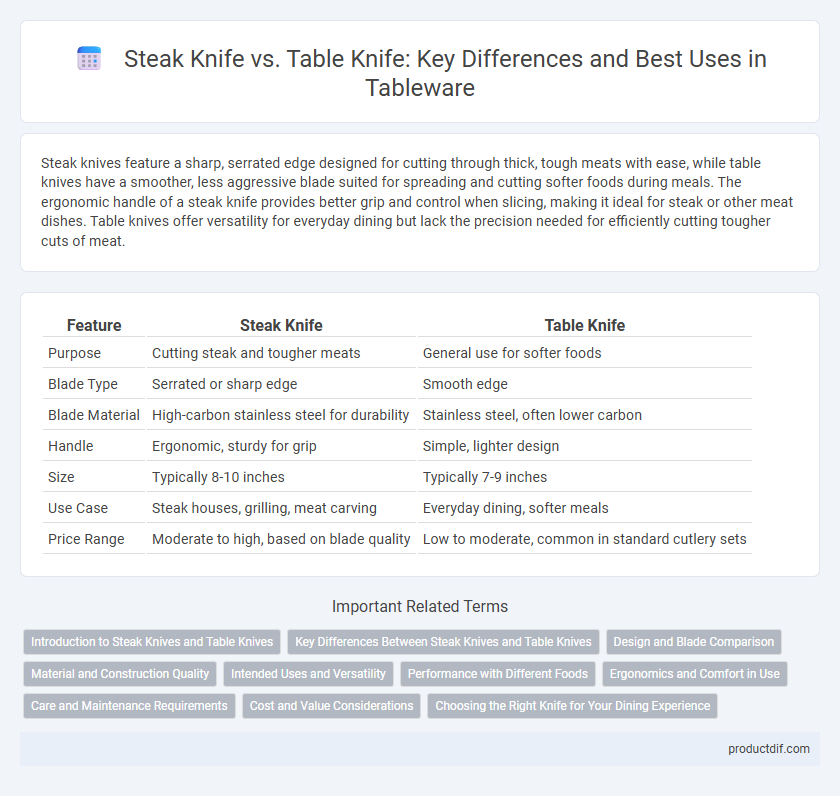Steak knives feature a sharp, serrated edge designed for cutting through thick, tough meats with ease, while table knives have a smoother, less aggressive blade suited for spreading and cutting softer foods during meals. The ergonomic handle of a steak knife provides better grip and control when slicing, making it ideal for steak or other meat dishes. Table knives offer versatility for everyday dining but lack the precision needed for efficiently cutting tougher cuts of meat.
Table of Comparison
| Feature | Steak Knife | Table Knife |
|---|---|---|
| Purpose | Cutting steak and tougher meats | General use for softer foods |
| Blade Type | Serrated or sharp edge | Smooth edge |
| Blade Material | High-carbon stainless steel for durability | Stainless steel, often lower carbon |
| Handle | Ergonomic, sturdy for grip | Simple, lighter design |
| Size | Typically 8-10 inches | Typically 7-9 inches |
| Use Case | Steak houses, grilling, meat carving | Everyday dining, softer meals |
| Price Range | Moderate to high, based on blade quality | Low to moderate, common in standard cutlery sets |
Introduction to Steak Knives and Table Knives
Steak knives feature a sharp, often serrated blade designed specifically for cutting through thick, fibrous meats with precision and ease, providing a clean slice without tearing. Table knives, also known as butter knives, have a blunt edge and rounded tip primarily intended for spreading butter or softer foods, making them less effective for cutting steak. Understanding the distinct functions and blade designs of steak knives versus table knives enhances both dining efficiency and meal presentation.
Key Differences Between Steak Knives and Table Knives
Steak knives feature a sharp, often serrated edge designed for cutting through tougher meats, while table knives typically have a smooth edge suitable for spreading and cutting softer foods. The blade length of steak knives is generally longer and narrower compared to the shorter, broader table knives. Steak knives are commonly used in casual and steakhouse dining settings, whereas table knives are standard in formal place settings for a versatile range of meals.
Design and Blade Comparison
Steak knives feature a sharp, serrated blade designed to cut through tough meats with ease, while table knives typically have a smooth, blunt edge suited for spreading and cutting softer foods. The design of steak knives often includes a sturdy, ergonomic handle for a secure grip during vigorous slicing, contrasting with the more streamlined, lightweight handle of table knives aimed at versatility and comfort. Blade materials for steak knives tend to be high-carbon stainless steel for durability and sharpness retention, whereas table knives prioritize corrosion resistance and ease of cleaning.
Material and Construction Quality
Steak knives typically feature high-carbon stainless steel blades for enhanced sharpness and durability, coupled with sturdy handles made from wood, resin, or stainless steel to withstand rigorous use. Table knives often have softer stainless steel blades with polished edges designed for spreading and cutting softer foods, and their handles are usually lighter and crafted from plastic or metal alloys. The construction quality of steak knives emphasizes precision cutting and long-lasting edge retention, while table knives prioritize comfort and overall balance for everyday dining.
Intended Uses and Versatility
Steak knives feature a sharp, serrated blade designed specifically for cutting through tough meats like steak, ensuring precise and effortless slicing. Table knives have a smoother, blunt edge intended for spreading and cutting softer foods, making them more versatile for general dining purposes. While steak knives excel in handling dense proteins, table knives serve a broader range of tasks from spreading butter to cutting cooked vegetables.
Performance with Different Foods
Steak knives feature sharp, serrated blades tailored for effortlessly cutting through tough meats without tearing fibers, delivering precise and clean slices. Table knives have a blunt, smooth edge designed primarily for spreading and cutting softer foods like vegetables and butter, offering controlled, gentle cutting. Using a steak knife on tougher foods enhances performance by maintaining blade sharpness and reducing effort, whereas a table knife performs better with delicate items, minimizing damage and maintaining food presentation.
Ergonomics and Comfort in Use
Steak knives feature serrated blades and ergonomic handles designed for a firm grip and precise cutting, reducing hand fatigue during meals. Table knives typically have a smooth edge and balanced weight distribution, promoting comfort during general dining tasks without requiring excessive pressure. Both knives prioritize user comfort, but steak knives excel in ergonomics for cutting tougher meats.
Care and Maintenance Requirements
Steak knives require regular sharpening to maintain their serrated or straight edges, ensuring efficient cutting performance, while table knives generally need less frequent sharpening due to their blunt edge design. Both types benefit from hand washing and immediate drying to prevent rust and preserve blade integrity, especially those made from high-carbon steel. Proper storage in a knife block or magnetic strip helps avoid blade damage and extends the lifespan of steak and table knives alike.
Cost and Value Considerations
Steak knives typically cost more due to their specialized stainless steel blades and ergonomic handles designed for cutting meat efficiently. Table knives, often made from less expensive materials with simpler designs, provide essential functionality at a lower price point. Investing in steak knives offers greater durability and sharper performance, delivering improved value for frequent use in dining settings involving tougher meats.
Choosing the Right Knife for Your Dining Experience
Selecting the right knife for your dining experience enhances both functionality and enjoyment. A steak knife features a sharp, serrated blade designed to effortlessly cut through tough meat fibers, making it essential for savoring steaks and hearty dishes. In contrast, a table knife has a smooth edge ideal for spreading butter and slicing softer foods, providing versatility for everyday meals and formal settings.
Steak Knife vs Table Knife Infographic

 productdif.com
productdif.com